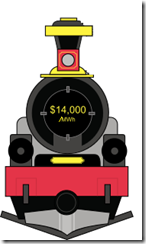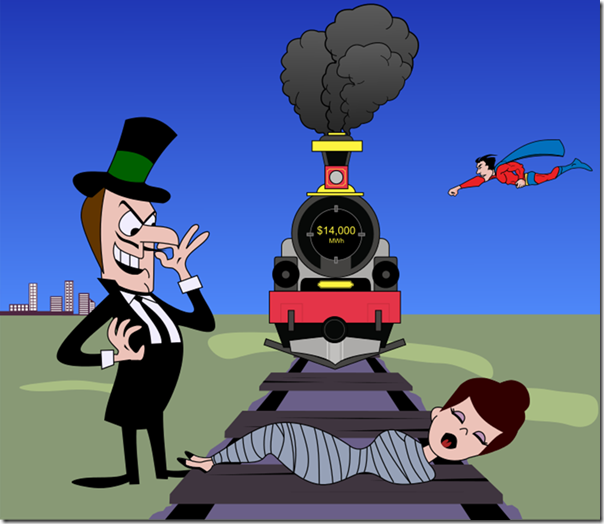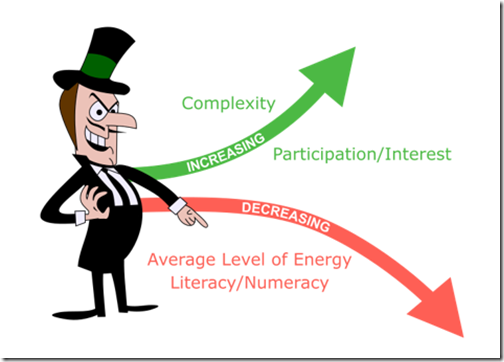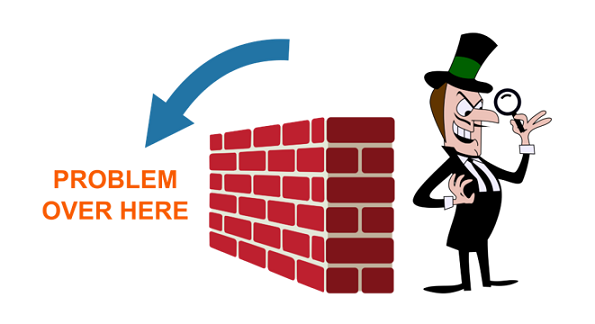It’s become increasingly commonly noted that we’re suffering from a real crisis in the Australian domestic energy sector.
Back on 20th July I posted about the “train wreck” of a crisis that has befallen us (which followed my presentation at Clean Energy Summit on the same topic). I used this image to identify the four key characters in this unfolding drama:
The Energy Crisis that’s upon us:
(a) has not crept up on us silently (I. along with others, have been pointing out leading indicators for years),
(b) nor has it suddenly emerged.
Rather, it’s been through a combination of factors that it has emerged. Perhaps all of these factors could (and should) have been seen in advance?
In my simplified depiction above, there are only four characters shown
Character #1 = the “Hapless Victim”
 |
On 18th August I had some time to post about how energy users are the victims in this train wreck that is escalating before our eyes. |
Character #2 = the 10 Villains
Today and tomorrow, the AFR are running their “National Energy Summit” in Sydney. I imagine that there will be much discussion about this energy crisis over the two day period – both amongst people present, and also online.
This kind of discussion has been running for quite some time (more than occasionally devolving into a counterproductive “blame game”).
1) On 25th September in the SMH Ross Gittins describes the situation in an article titled “Everyone has a different excuse for the electricity stuff-up” . In my view it would have been more correct to stop thinking of them as “excuses” and start thinking of them as “causes” (i.e. to help reinforce that they are real).
2) Back on 14th March, Matthew Warren urged a focus on causes not symptoms. More recently, on 26th September in this article in the AFR Matthew notes “After debating about how to run it for more than a decade, the giant machine that provides electricity to the east coast of Australia continues to slowly degrade. Higher prices are a market signalling supply shortages. The threat of blackouts is the next logical warning of what happens when we manage to argue about a problem for so long without doing anything. Remarkably, while one of the fundamental systems needed to run the economy falters, we remain trapped in an ideological debate about how to fix it; the merits of different fuel types, the nature of policy risk, climate change and even how much life is left in old power stations.”
3) Further back on 26th February, Ben Potter mentioned nebulous “vested interests” as part of the problem.
4) On 12th March, Brian Toohey wrote about at market rules as a “hidden cause” of the crisis.
5) On 10th March, David Leitch wrote about (confused) structure and accountability.
6) Back on March 13th the (now former) CEO of the Minerals Council, Brendan Pearson wrote about a level playing field (notwithstanding that talk about “privatising profits whilst socialising costs” has many angles).
7) Back on 10th March, without a note of irony, the Clean Energy Council called for stable policy and accelerating reform.
8) Back on 20th February, Greg Houston (from Houston Kemp) advocated 5 fixes for the NEM.
9) On 14th February, Tony Wood talked about lack of integrated climate and energy policy (one of many times this continues to be mentioned). More recently, on 26th September in this article in the AFR Tony notes “Australian homes and businesses need governments and the energy industry to deliver secure and affordable electricity, over the next few summers and beyond. Yet the current government versus industry stand-off over domestic gas supply is a case study in apportioning blame instead of solving the problem”.
10) On 16th February, Keith Orchison talked about the National Electricity Objective.
11) Also on 20th February, Mark Christensen talked here about privatisation.
12) Bruce Mountain called for devolution back to the states (and here talks about a crisis of good governance).
… and on and on it goes…
My sense own sense is that we’re scrambling for “solutions” without really getting down to “Root Causes”, which seems a recipe for not really reaching a durable, long-term resolution. I have identified 10 Root Causes (or Villains) that will be progressively expanded on in the table below:
| Villain #1 | Any objective review of the collective performance of our group of politicians over the last 10+ years would return the result of “Fail”.
Our current, past, and prospective leaders all stand out, head and shoulders, as the grand architects of the current energy fiasco: |
Villain #2 |
However our elected representatives aren’t featured alone on the “wall of shame”.
As posted on Wednesday 11th October, it’s clear to me that we, the voting public, have been collectively presenting an almost intractable problem our political leaders (both state and federal, across all parties). That’s why we’re Villain #2. |
| Villain #3
|
Had to wait until 22nd January 2018 to post in those at both extremes of the Emotion-o-Meter as Villians #3. |
| Villain #4 | On 20th July 2018, I posted about how we’re seeing a yawning gap open up between current capacity, and requirement for “Energy Literacy” as one thing standing in our way of a smooth energy transition. Feedback from many others since this time has suggested that many others have been observing the same thing. |
| Villain #5 | On 9th October 2018, I posted about the way we sometimes don’t take the first step of correctly defining the problem we’re trying to solve as something that ends up with us heading down the wrong path to a solution. |
| Villain #6 |
On November 8th 2018 I posted this article, about a tendency to reach for a “magic wand” as Villain no 6 in this looming energy transition train wreck. A bit like Angus Taylor’s “big stick”, with with added magic attached. |
| Villain #7 |
On 9th March 2020 I posted an article about Villain no 7 (the form of support we’ve used for Wind and Solar developments).
I asked whether ‘we’ve been killing new entrants with kindness?‘. |
Villain #8 |
On 21st June 2021 I wrote about how ‘the Invisible Man’ was seen as Villain no 8.
Note that this villain is seen in a number of different manifestations! |
| Villain #9 | Still to find time to post about Villain #9…. |
| Villain #10 | Still to find time to post about Villain #10…. |
I look forward to hearing your thoughts about the above, as the matrix above is developed…
Character #3) The means of destruction
 |
I’ve used the train to illustrate the means of destruction for we, the energy user (and victim).
I’ll discuss more here what this means |
Character #4) The “superhero” saviour
 |
Many simplified stories have the superhero included, to fly in and save the day.
I am wondering if such a character exists in the energy policy train wreck drama, and will post more about this later. |







Paul, I look forward to reading this article as it evolves. No doubt you’ll get this completed before the villains even realise that root cause analysis is actually the first step they have to take.
Paul you constantly nail it on the head. However there is one big thing that I wish to add. The bill – 80% of bills that I see can be reduced. Yes, 80% of businesses are paying more than they need to pay for the same power. Why? its all too complicated and its not their core business. Well it is my core business and I am helping businesses save tens of thousands of dollars from the grass roots level. Happy to chat to you any day to discuss this mess. What character am I?
Villain number one is John Howard who signed and published a fundamentally flawed Energy White Paper in June 2004
Assumption of 100 years of gas
https://pbs.twimg.com/media/DLmukgjVoAAefj3.jpg
You haven’t explained where Howard or that paper were wrong….in the quantities…or just the crime of using a fossil fuel?
If the latter and you are a true believer in CAGW…can you tell me why Australia alone in the world must be the country that commits economic and social suicide because the world warmed a small amount …over a period of 20 years at most…a tiny blip in the scheme of things….starting and finishing with two entirely natural warming events….and followed since then by an IPCC-admitted…recently-reiterated PAUSE??
Can you tell me why that tiny all-natural warming trend set within a steady slight warming over hundreds of years as the earth emerges from the Little Ice Age …warming that wasn’t initiated by a rise in CO2…the CO2 rise having followed the warming …can you tell me why these entirely natural events require Australia to commit hari kari …destroying our children’s futures ?
Can you tell me why the earth WOULDn’t be slightly warming …or did you …IF you’re a warmist…thinks the earth should have retained all that ice from the LIA…and be all iced up now and maybe cooling towards ICE AGE ARMAGEDDON